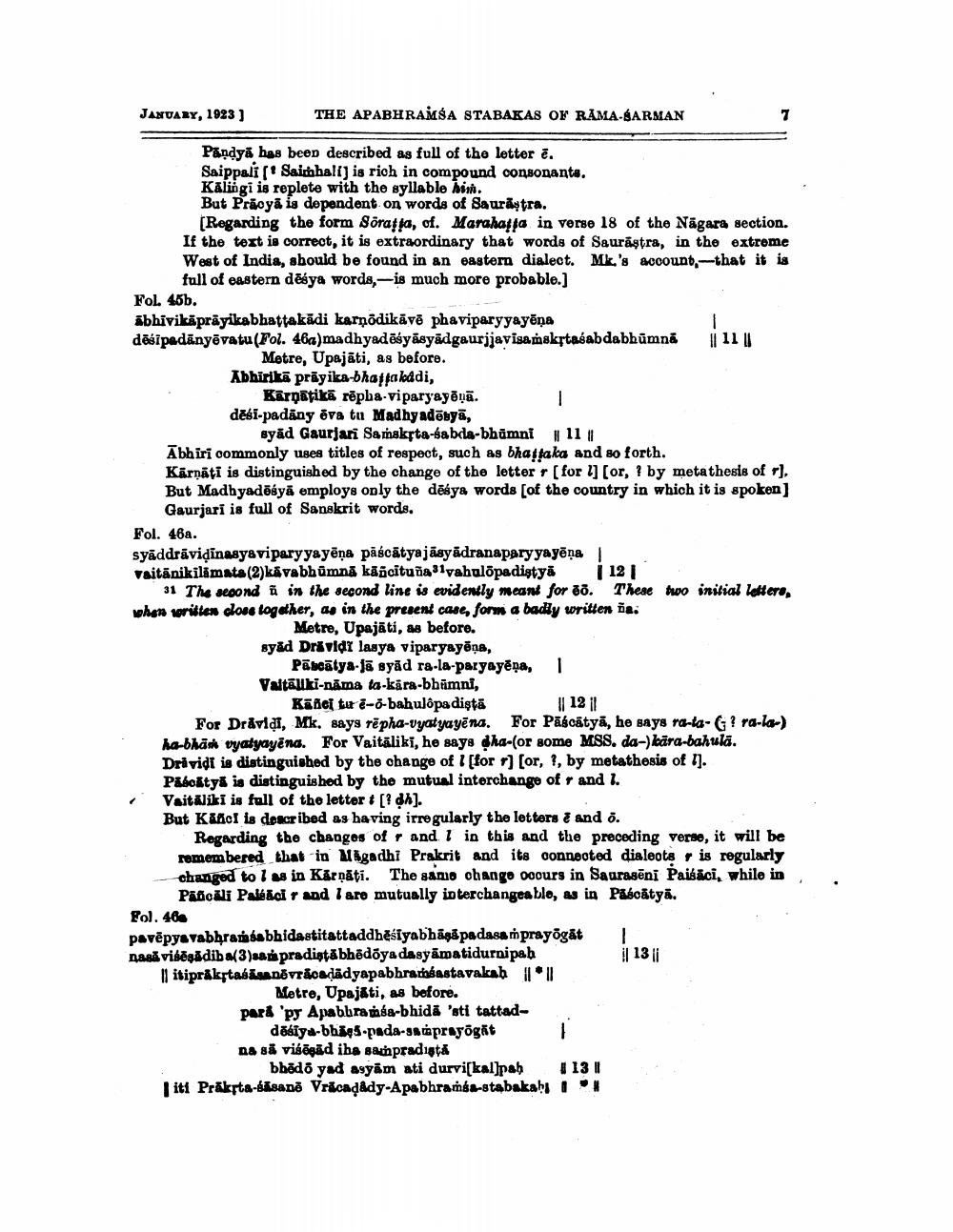________________
JANUARY, 1923)
THE APABHRAMA STABAKAS OF RAMA-SARMAN
Pandyā has been described as full of the letter ē. Saippali ( Saimhall) is rich in compound consonanta. Kāliigi is replete with the syllable him. But Prãoyā is dependent on words of Saurastra.
Regarding the form Söratta, of. Marahatla in verse 18 of the Nāgara section. If the text is correct, it is extraordinary that words of Saurastra, in the extreme West of India, should be found in an eastern dialect. Mk's account,--that it is
full of eastern dēsya words,- is much more probable.] FOL. 45b. abhivikäpräyikabhattakādi karņodikāvē phaviparyyayēņa dēsipadānyēvatu(Fol. 46a)madhyadēśyāsyādgaurijavisamskrtasabdabhūmnă || 11 ||
Metre, Upajāti, as before. Abhirika prāyika-bhaftakddi,
Karnatikā rēpba-viparyayānā. desi-padany ēva tu Madhyadēbyā,
gyad Gaurjari Samakta-sabda-bhūmni 11 | Abhiri commonly uses titles of respect, such as bhaftaka and so forth. Kārnāti is distinguished by the change of the letter (for l] [or, ? by metathesis of r). But Madhyadēśyā employs only the dēsys words of the country in which it is spoken)
Gaurjari is full of Sanskrit words. Fol. 46a. syäddrāviļinasyaviparyyayēņa pāścātyajāsyādranaparyyayēņa vaitānikilāmata (2)kivabhūmná kāñcītuña Ivahulopadistyä | 12
31 The second á in the second line is evidently meant for 88. These two initial letters, when written clous together, as in the present case, form a badly written ia.
Metre, Upajāti, as before. syad Drivide lasya viparyayēna,
Pābcātya-jā syad ra-la-paryayēņa, 1 Valtallki-náma ta-kara-bhamni,
Kūlici tu e-o-bahulopa diştā || 12 il For Dråvidt, Mk, says rēpha-vyatyayēna. For Pascātyä, he says ra-la-G? ra-la-) ha-bhänk vyatyayēna. For Vaitāliki, he says Pha-(or some MSS. da-) kära-bahula. Drividi is distinguished by the change of 1 [for r) (or, ?, by metathesis of 1). P&botyk is distinguished by the mutual interchange of and I. Vaitaliki is fall of the letter * [? dh). But Kafici is described as having irregularly the letters & and o.
Regarding the changes of and I in this and the preceding verse, it will be remembered that in Magadhi Prakrit and its connected dialeotaris regularly changed to l as in Kärnāti. The same change ooours in Saurasēni Paisāci, while in
Pañali Palhacir and I are mutually interchangeable, as in Pasoátyā. Fol. 46 pavēpysvabhrana sabhidastitattaddhesiyabhāgā padasaṁprayõgät nasā vidēg dib a(3)aada pradiatábhēdöya dasyāmatidurnipab
|| 13 | 11 itipråkftasimanovracadadyapabhraíbastavakahill
Metre, Upajati, as before. pard 'py Apabbra msa-bhidā 'sti tattad
désiya-bhs-pada-ssprayógāt na să visāgad iba sa pradiată
bhodo yad asyām ati durviskal]pah 113 | iti Prāksta-basano Vrloadedy-Apabhraíbastabakah #




